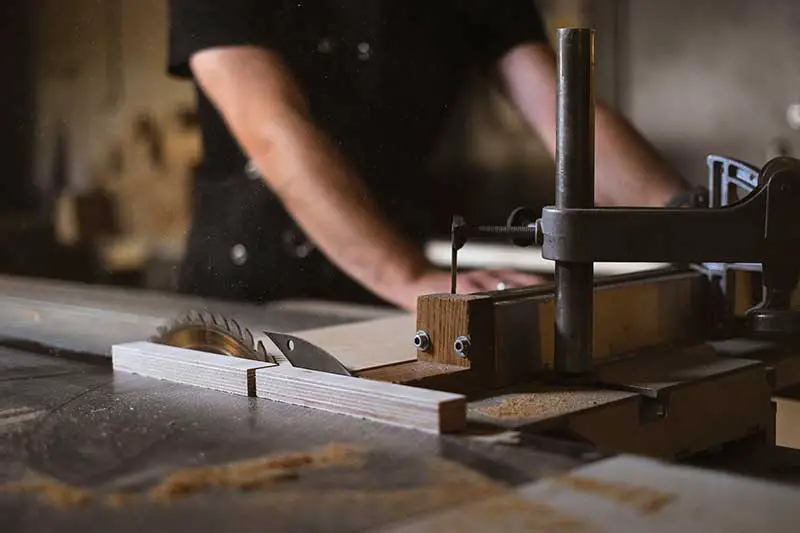A good RPM for a table saw typically ranges between 3,000 to 5,000 RPM, depending on the saw type and material being cut. The ideal RPM ensures efficient cutting and safety during operation.

Table saws are essential tools in woodworking, used for cutting various materials with precision and ease. The RPM (revolutions per minute) of a table saw is a crucial factor that determines its cutting efficiency and the quality of the cuts. In this article, we’ll explore the ideal RPM range for table saws and factors that can affect it.
Understanding RPM
RPM refers to the number of revolutions a table saw blade makes in one minute. The speed at which the blade spins affects the quality of the cuts and the overall efficiency of the saw. A higher RPM allows for faster cutting, while a lower RPM might provide smoother cuts but at a slower pace.
Ideal RPM Range for Table Saws
The ideal RPM range for table saws varies depending on the type of blade and material being cut. Generally, table saws operate within the range of 3,000 to 5,000 RPM. Here’s a breakdown of the recommended RPM range for various types of blades:
- Standard Blades: These blades are typically designed for general-purpose cutting and operate at a range of 3,000 to 4,000 RPM.
- Thin-kerf Blades: These blades have a narrower kerf and require less power to operate, making them suitable for lower-powered table saws. They usually perform well at speeds between 3,000 and 5,000 RPM.
- Specialty Blades: Specialty blades, such as dado blades, may require specific RPM settings depending on the manufacturer’s recommendations.
Factors Affecting Ideal RPM
There are several factors that can affect the ideal RPM for your table saw:
- Blade Diameter: Larger blades require lower RPMs than smaller blades to maintain the same cutting speed.
- Material: Harder materials may require higher RPMs for efficient cutting, while softer materials might benefit from lower RPMs.
- Blade Type: Different blade types, such as ripping blades, crosscutting blades, or dado blades, may require different RPM settings to optimize their performance.
How to Adjust Table Saw RPM
Most table saws have a fixed RPM setting, which is usually optimized for general-purpose cutting. However, some table saws come with variable speed controls that allow you to adjust the RPM based on the type of material and blade being used. To adjust the RPM on a variable speed table saw, consult the user manual for specific instructions.
Safety Considerations
It’s essential to prioritize safety when operating a table saw, regardless of the RPM setting. Always follow these safety guidelines:
- Wear appropriate safety gear, such as safety glasses, hearing protection, and a dust mask.
- Use a riving knife or splitter to prevent kickback.
- Make sure the blade is sharp and clean.
- Adjust the blade height so that it extends just above the top of the workpiece.
- Follow the manufacturer’s recommendations for proper RPM settings.
| Key Takeaway | Description |
|---|---|
| Ideal RPM Range | 3,000 to 5,000 RPM, depending on the blade type and material |
| Factors Affecting RPM | Blade diameter, material type, blade type |
| Adjusting RPM | Check the user manual for instructions on adjusting the RPM on variable speed table saws |
| Safety Considerations | Wear safety gear, use a riving knife or splitter, keep the blade sharp and clean, adjust blade height, and follow the manufacturer’s recommendations for RPM settings |
Tips for Choosing the Right RPM
When deciding on the appropriate RPM for your table saw, consider the following tips:
- Refer to the Blade Manufacturer’s Recommendations: Check the packaging or documentation that comes with your blade for specific RPM recommendations. This will help ensure optimal performance and prevent damage to the blade or table saw.
- Consider the Material: Harder materials may require higher RPMs for efficient cutting, while softer materials might benefit from lower RPMs. Adjust the RPM as needed based on the type of material you’re working with.
- Test Different RPM Settings: If you have a variable speed table saw, experiment with different RPM settings to find the ideal speed for your specific cutting needs. Start with a lower RPM and gradually increase it until you achieve the desired cut quality and efficiency.
- Monitor Saw Performance: Keep an eye on your table saw’s performance while cutting. If you notice excessive vibration, burning, or rough cuts, adjust the RPM accordingly to address the issue.
Conclusion
The ideal RPM for a table saw varies depending on factors like blade type, material, and blade diameter. Generally, table saws operate within the range of 3,000 to 5,000 RPM. If your table saw has variable speed controls, consult the user manual and the blade manufacturer’s recommendations to adjust the RPM based on your specific cutting needs. Prioritize safety and follow guidelines to maintain a safe working environment.
